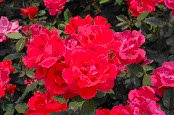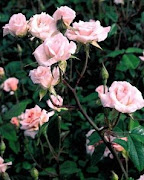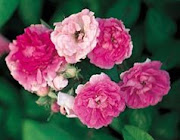
Billie (aka Oddly Sassy) told me about an article in the Fort Worth Star Telegram that was very interesting. I'm including some highlights below because I think they're important.
Breakthrough that can supercharge your menu (for no extra calories)
Finally, an answer to the supermarket-aisle question: Are organics worth the extra cost? A review of nearly 100 studies shows that the average levels of nearly a dozen nutrients are 25 percent higher in organic fruit, veggies and grains than in conventionally grown produce. In some studies, organic options had nearly 50 percent more of the antioxidants quercetin and beta-carotene.
Stay healthy: Buy organic produce when you can — it’s pricier, but you get more bang for your buck, says Kathleen Merrigan, Ph.D., assistant professor of nutrition at Tufts University. And that’s not counting the benefits that come from reducing the amount of pesticides that enter the groundwater — and your body. "You’ll really do your health good if you splurge on organic as much as possible in the produce aisle," she says. If you have to be selective, she adds, pick organic versions of the fruits and vegetables that tend to have the highest pesticide residues. For a list of the most contaminated produce — plus other buying tips — go to prevention.com/budgetorganic.
Finally, an answer to the supermarket-aisle question: Are organics worth the extra cost? A review of nearly 100 studies shows that the average levels of nearly a dozen nutrients are 25 percent higher in organic fruit, veggies and grains than in conventionally grown produce. In some studies, organic options had nearly 50 percent more of the antioxidants quercetin and beta-carotene.
Stay healthy: Buy organic produce when you can — it’s pricier, but you get more bang for your buck, says Kathleen Merrigan, Ph.D., assistant professor of nutrition at Tufts University. And that’s not counting the benefits that come from reducing the amount of pesticides that enter the groundwater — and your body. "You’ll really do your health good if you splurge on organic as much as possible in the produce aisle," she says. If you have to be selective, she adds, pick organic versions of the fruits and vegetables that tend to have the highest pesticide residues. For a list of the most contaminated produce — plus other buying tips — go to prevention.com/budgetorganic.
Breakthrough that can help you control hunger and lose weight
A kind of dietary fiber known as "resistant starch" is emerging as a new weight-loss powerhouse. A 2008 Swedish study found that people who ate a resistant starch at supper (in the form of barley bread) felt much less hungry than those who munched on plain white bread — and the hunger-quenching effect lasted past breakfast the next day. Found in beans, slightly green bananas and potatoes (white and sweet), among other foods, this kind of fiber "resists" being digested. Because the starch doesn’t enter your bloodstream, it stabilizes blood-sugar levels and may lower diabetes risk. It also boosts levels of healthful bacteria that nurture the immune system.
Stay healthy: Load up your diet with these indigestible carbohydrates, also found in brown rice and corn, says Leslie Bonci, a registered dietitian and author of the American Dietetic Association Guide to Better Digestion. Because the starch becomes resistant during cooling, serve these foods at room temperature or from the fridge — think three-bean salad or potato salad made with low-fat mayonnaise. You can find foods fortified with a resistant starch made from corn under the brand name Hi-maize (see our picks at prevention.com/starch). "If you’re eliminating carbs to watch your weight, you’re not doing yourself any favors," Bonci says. "Adding these starches is an easy way to control both hunger and blood sugar."
Then I ran across THIS info today:
According to the USDA the following foods had the highest level of pesticide contamination.
Nectarines – 97.3% of nectarines sampled were found to contain pesticides.
Celery – 94.5% of celery sampled were found to contain pesticides.
Pears – 94.4% of pears sampled were found to contain pesticides.
Peaches – 93.7% of peaches sampled were found to contain pesticides.
Apples – 91% of apples sampled were found to contain pesticides.
Cherries – 91% of cherries sampled were found to contain pesticides.
Strawberries – 90% of strawberries sampled were found to contain pesticides.
Imported Grapes – 86% of imported grapes (i.e. Chile) sampled were found to contain pesticides.
Spinach – 83.4% of spinach sampled were found to contain pesticides.
Potatoes – 79.3% of potatoes sampled were found to contain pesticides.
Bell Peppers – 68% of bell peppers sampled were found to contain pesticides.
Red Raspberries – 59% of red raspberries sampled were found to contain pesticides.
The following list of produce contains the least amount of pesticides.
Asparagus
Avocados
Bananas
Broccoli
Cauliflower
Corn (However, almost all corn is genetically modified)
Kiwi
Mangoes
Onions
Papaya
Pineapples
Sweet Peas
Makes you want to grow your own veggies, doesn't it? For those of you who don't know about square foot gardening, here's some basic info that might encourage you to start your own. This is what a 4 ft by 4 ft square-foot garden look like. You can grow sprawling veggies/melons/etc vertically on the back row of the garden.

This is from US News and World Report - Dec. 18, 2008:
Even klutzy, brown-thumbed apartment dwellers can cut their food bills, eat better, and reduce their carbon footprint. Just plant a "square-foot garden," says Mel Bartholomew, author of "All New Square Foot Gardening".
All it takes is some sort of wooden, plastic, or brick box or frame. (You may have to cut holes in the bottom for drainage.) Fill the frame with equal parts compost, peat moss, and vermiculite, available at home and garden stores.
Put the box in any yard, or place it on a patio, deck, or stoop that gets at least six hours of sunlight a day.
Bartholomew recommends laying a 1-foot-by-1-foot wooden or plastic grid over the box to organize the miniature garden. Then, it's just a matter of planting—16 radish seeds, say, or one prestarted tomato plant per 1-foot square. Attaching a nylon net to climbing plants (like cucumbers and beans) will help increase harvests, as the plants grow up and leave room for other plants in the other squares. Because the clean compost probably won't be weedy, the only ongoing chore is watering carefully for the five or six weeks until the first radishes or lettuce leaves are ready to eat. Once you've harvested everything out of a square, just replenish the soil with a handful of compost and plant something else.
Bartholomew estimates one 4-foot square box will produce one meal's worth of vegetables a day for one adult through the growing season—typically about five months. Anyone who's priced fresh organic vegetables lately knows that's a savings of at least $15 a week.
A recent paper by a Rutgers nutritionist and others found that gardeners—especially children—became so enthusiastic about their crops that they ate more vegetables and less junk food. In addition, gardeners get more and better vitamins, since store-bought produce is often so old that it is less nutritious.
A recent paper by a Rutgers nutritionist and others found that gardeners—especially children—became so enthusiastic about their crops that they ate more vegetables and less junk food. In addition, gardeners get more and better vitamins, since store-bought produce is often so old that it is less nutritious.
Some square-foot gardeners are even selling their extra organic, local produce to raise a little cash. In this economy, cash might be the most welcome crop of all.
And here are some blogs that talk about square-foot gardening:
I've just started working on my plan for this years square-foot garden. Last year we had some problems. First off, I started it too late because I had been ill. Then the grasshoppers ate a lot of the good stuff and on top of everything was just too darned hot for some things. Even with all the problems, I got a good crop of tomatoes, beans and basil. I've got some plans for this year and I'm hopeful to be bringing in a really good harvest of other things we love -- like bell peppers, zucchini and cantaloupe. I may even create a second area just for corn, because Lord knows we love fresh corn at our house.
I'll post some pictures as it comes along. Wish me luck!













No comments:
Post a Comment